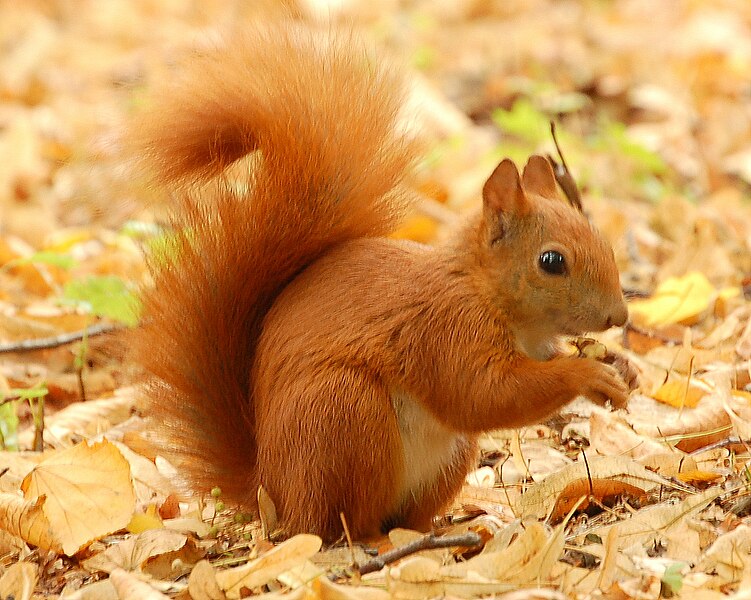Squirrels are one of the most common mammals in North America. You will often see squirrels roaming in parks, backyards, or near your home. They are so common that they are considered to be a nuisance and pests in most urban environments.
Despite their relatively short lifespan, squirrels continue to thrive in urban and suburban settings, leading many to wonder “where did squirrels originate?” This article will explore the history of squirrels, their habitats, and how they have adapted to the modern world. We will also look into some other interesting facts about these furry little creatures.
Squirrel Origins – Where Did Squirrels Come From?
The first squirrel, resembling the ones we have now, appeared about fifty million years ago during the Eocene period. During this time there was a wide spread of forests covering most parts of North America and Eurasia.
The ancient ancestors of tree squirrels were small mammals that mainly ate fruits or nuts which led them to live in trees for shelter and food resources. When these creatures became extinct ten to twenty million years later due to climate change, their closest relatives survived better because they had advanced dexterity with their paws, greater stamina by being able to hibernate through cold periods as well as other abilities including climbing down trees headfirst so they have better control over their descent.
Over time, these squirrels developed different color variations and larger ears for better hearing in order to protect themselves from predators such as birds of prey. They also had a flat tail that was used for balance while running or climbing through trees quickly. Squirrels were able to flourish during this period because they could outwit their predators by using the resources available around them more efficiently than other animals competing for the same food sources. This is how the tree squirrel got its start on this continent!

Origin of the Name
The word “squirrel” was first attested in 1327 and comes from Anglo-Norman esquirel which is itself from Old French escurel, the reflex of a Latin word sciurus. Sciurus also was derived from an ancient Greek word skiouros meaning ‘shadow-tailed’. The name was likely based on the squirrel’s most distinctive feature, its bushy tail.
Where Do Squirrels Originate From?
There are theories for this question. One is that squirrel ancestors lived in trees and over time evolved to move down to the ground because they were being hunted by predators who came from above them.
Once these creatures adapted into their new habitat, they began hoarding acorns as a food source which eventually led them back up into trees since it was easier to hide their stash there.

This theory may be supported due to bones found of an animal called Protosciurus dating back 50 million years ago during the Eocene epoch. These fossils show evidence of teeth suitable for both tree living and feeding on insects below bushes or other low vegetation types similar to how modern-day squirrels behave today.
Today’s modern-day squirrel has evolved into three subfamilies: Sciuridae (most are tree squirrels like the eastern grey squirrel), Xerinae (which live near water), and Marmotini (found on grasslands). These subfamilies include over 280 different species across six continents including Europe, Asia, Africa, and Australia.
19th Century Urban Parks and Their Impact on Squirrels in America
Squirrel populations would not be what they are today if it were not for 19th-century people adding green spaces to their cities such as Boston Common which was created in 1634 or New York’s Central Park that opened its gates in 1858. These parks allowed squirrels to multiply exponentially due to the number of resources available to them in these habitats.
The American Urban Squirrel
During the 19th century, cities in America were beginning to grow rapidly due to industrialization and immigration from Europe. These growing urban areas caused an increase in deforestation because trees were being cut down for wood or land was cleared out so that housing could be built.
Because of this rapid growth, city landscapers began creating parks throughout these developing cities as a way for people living there to enjoy green spaces without having to venture out of the city limits.
This is where squirrels came into play! Squirrels are natural tree climbers and can be found in forests, so landscapers decided to release eastern grey squirrels into the parks they were creating so the parks would appear more natural. They helped these animals thrive by feeding them different types of foods.
Although nobody realized it at the time, releasing gray squirrels into parks had long-term consequences for other areas because their populations started growing exponentially once they got established in cities.
This is how the first urban squirrels came about – through a combination of deforestation and people’s desire to have green spaces in their cities. Squirrel populations can be found all over the world because they are able to adapt to different habitats with ease.
Boom of 19th Century Urban Parks
In the early 19th century, squirrels were not as commonly seen in cities and were mostly just in the woods located outside of the cities. This all changed when Frederick Law Olmstead and Calvert Vaux designed and built Central Park in 1857. They had a vision for this park to be like a refuge from the busy streets of New York City where people could venture into nature without leaving their city limits.
The boom of urban parks in the 19th century led to squirrels being successfully introduced into cities. The planner’s reason for their introduction was to “have things of beauty in the city”. This created opportunities for people to experience nature and all that came with it without having to go very far out of their daily routine.
The idea is that nature inside cities keeps people sane and healthier which therefore makes them more productive citizens. It was also a way for cities to attract people with this “natural beauty”.
These creatures were soon found in parks all across North America. The people loved them and conservationists see people’s act of feeding squirrels as a way to “help humans learn to treat animals better”. Since then, their population has continued growing exponentially.
The parks became an extremely popular place where visitors could come and enjoy trees, flowers, and other green spaces. The squirrels were also among these attractions because people loved seeing them run around or climb up the trunks of trees.
From Favorites to Pests
By the early 20th century though, squirrels are starting to be seen as nuisance animals. Their population has grown to such a high number that they’re starting to cause problems for the residents of the city. They were seen as a menace for invading attics and garages, knocking down bird feeders, stealing food, and much more.
This is where the opinions of squirrels in cities began to change and they were seen as pests animals rather than cute creatures that people enjoyed watching throughout their daily lives. By the end of the 20th century, it became almost a sin to feed them as it’s considered to be rewarding the squirrels for being pests and encouraging their destructive behavior – a very different treatment than what they were receiving just a few decades earlier.
Squirrels are still common inhabitants of cities in the US and you can often see them running around parks or sidewalks. Now, though, they are viewed more as troublesome creatures than anything else.
The Urban Squirrel Today
Today, the Eastern gray squirrel is most common to be found in parks and backyards within North America. They are known for their bushy tails which help them steer through trees when they’re running away from people or dogs. These little creatures have adapted into living with people: moving into attics of homes, getting into birdfeeders to grab a quick snack, and running around the trees in your back yard.
They are so common that they can be seen chasing other squirrels around, fighting for food, and chasing people and pets! These creatures are so comfortable with humans that they will try to snatch food right out of your hand.
Squirrels thrive in cities because of human development and our waste management systems which provide them with an abundance of foods to eat including nuts, seeds, and our garbage. They live in nests that they build up high on the tree branches or inside of a structure such as your attic! For squirrels in attic problems, call AAAC Wildlife Removal today.

Conclusion
As you can see, the history of squirrels in cities has been quite a roller coaster ride! From being brought to city parks by urban planners who wanted them around during people’s daily lives and giving nature an accessible form for everyone without having to venture far outside their homes; to being pest creatures that are causing major problems due to their population growing exponentially; to even now still being seen as pests but also very common creatures that you can see multiple times per day in the city.
Squirrels have been an integral part of this continent’s ecosystems since around fifty million years ago! Their ancestors developed new abilities that helped them live and reproduce successfully in their environment which has allowed for their population to flourish so much today! Now, squirrels come in all shapes and sizes – from big squirrels like oriental giant squirrels to tiny cute ones like the neotropical pygmy squirrel to flying squirrels, the squirrel family has it covered.
Squirrels have continued evolving into what we know today as creatures that don’t fear humans at all which has allowed them to thrive among cities full of life. While you might consider them pests due to the damage they cause, these little guys are necessary parts of nature’s ecosystem who help maintain balance within environments through seed dispersion.
Originally published on https://aaacwildliferemoval.com/blog/squirrels/where-did-squirrels-originate




